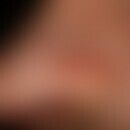Synonym(s)
Acantholytic dermatitis herpetiformis; Dermatitis herpetiformis acantholytic
HistoryThis section has been translated automatically.
Floden & Gentale, 1955
DefinitionThis section has been translated automatically.
Special form of pemphigus disease with herpetiform, itchy or burning, papulovesicular skin symptoms on an erythematous ground, usually in clinically manifest pemphigus foliaceus, rarely in pemphigus vulgaris.
You might also be interested in
Occurrence/EpidemiologyThis section has been translated automatically.
Rare (5-8% of all pemphigus diseases), panethnic, no sex predilection.
ManifestationThis section has been translated automatically.
Occurring in adults (30.-80. LJ), more common around the 60th LJ.
ClinicThis section has been translated automatically.
Intermittent course of the disease with dense, grouped, cluster-like arranged, tight, clear, 0.1-0.5 cm large blisters, which are localized on red spots or plaques. Burning or itching, 1-6 mm large, reddish-brown papules are also visible. With increasing duration of the acute episode, eroded and encrusted lesions and scratch excoriations are impressive. Only rarely does involvement of the oral mucosa occur.
HistologyThis section has been translated automatically.
Superficial blistering: acantholysis, eosinophilic spongiosis. Intraepidermal and subcorneal microabscesses with neutrophils and eosinophils.
Direct ImmunofluorescenceThis section has been translated automatically.
IgG, among others against desmoglein 1 and desmocollin 3 in the intercellular space of the epidermis.
DiagnosisThis section has been translated automatically.
Clinical, histology, immunohistology, ELISA (IgG against desmoglein 1, IgG against desmocollin 3 as well as IgA against desmoglein 1 are detectable).
Differential diagnosisThis section has been translated automatically.
TherapyThis section has been translated automatically.
S.u. Pemphigus vulgaris. Systemic glucocorticoids like prednisolone (e.g. Decortin H) initially 60-90 mg/day, then reduction to maintenance dose. Alternatively: DADPS (e.g. Dapson-Fatol) 50-150 mg/day p.o.
Progression/forecastThis section has been translated automatically.
Chronic recurrent course.
LiteratureThis section has been translated automatically.
- Ahmed AR, Sami N (2002) Intravenous immunoglobulin therapy for patients with pemphigus foliaceus unresponsive to conventional therapy. J Am Acad Dermatol 46: 42-49
- Enk AH, Knop J (1998) Adjuvant therapy of pemphigus vulgaris and pemphigus foliaceus with intravenous immunoglobulins. dermatologist 49: 774-776
- Floden C, Gentale H (1955) A case of clinically typical dermatitis herpetiformis (M. Duhring) presenting acantholylysis. Acta Derm Venereol (Stockh) 35: 128
- Goebeler M et al (2003) Blistering autoimmune diseases of childhood. dermatologist 54: 14-24
- Kozlowska A et al (2003) Pemphigus herpetiformis with IgA and IgG antibodies to desmoglein 1 and IgG antibodies to desmocollin 3 J Am Acad Dermatol 48: 117-122
- Luther H, Kastner U, Altmeyer P (1999) Comment on the contribution by Alexander H. Enk and Jurgen Knop. Adjuvant therapy of pemphigus vulgaris and pemphigus foliaceus with intravenous immunoglobulin Dermatologist 50: 372-374
- Marinovic B et al (2003) Coexistence of pemphigus herpetiformis and systemic lupus erythematosus. J Eur Acad Dermatol Venereol 17: 316-319
- Robinson ND (1999) The new pemphigus variants. J Am Acad Dermatol 40 (5 Pt 1): 649-671
Incoming links (3)
Autoimmune dermatoses, bullous; Dermatitis herpetiformis, acantholytic; Pemphigus drug-induced;Outgoing links (7)
Acantholysis; Dadps; Dermatitis herpetiformis; Glucocorticosteroids; Pemphigus foliaceus; Pemphigus vulgaris; Prednisolone;Disclaimer
Please ask your physician for a reliable diagnosis. This website is only meant as a reference.




